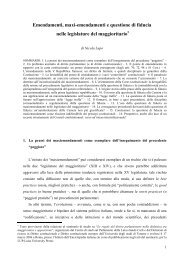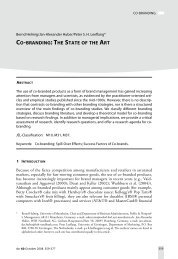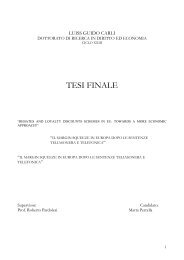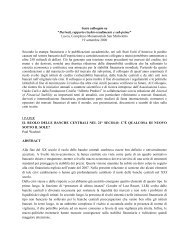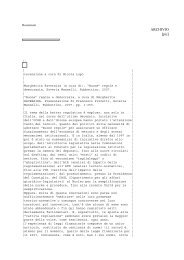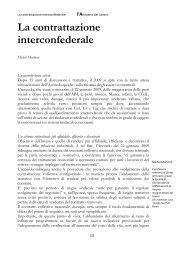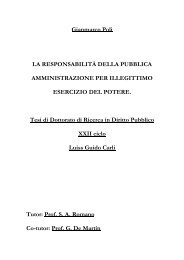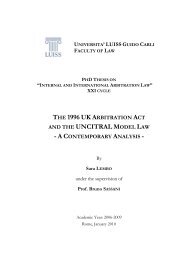Biometric authentication and authorization infrastructures in trusted ...
Biometric authentication and authorization infrastructures in trusted ...
Biometric authentication and authorization infrastructures in trusted ...
You also want an ePaper? Increase the reach of your titles
YUMPU automatically turns print PDFs into web optimized ePapers that Google loves.
<strong>Biometric</strong> <strong>authentication</strong> <strong>and</strong> <strong>authorization</strong> <strong><strong>in</strong>frastructures</strong> <strong>in</strong><br />
<strong>trusted</strong> <strong>in</strong>tra-organizational relationships<br />
Matthias Olden 1 , Stefano Za 2<br />
Abstract Today, the lives of both people <strong>and</strong> organizations are strongly focused on the creation,<br />
development <strong>and</strong> ma<strong>in</strong>tenance of relationships. These are <strong>in</strong>fluenced by several factors, amongst<br />
which trust plays an important role. Same as <strong>in</strong> traditional relationships, trust is considered crucial<br />
<strong>in</strong> their digital equivalent; here we can speak of the concept of trust <strong>in</strong> technology. An example for<br />
trust <strong>in</strong> technology is given by biometric <strong>authentication</strong> <strong>and</strong> <strong>authorization</strong> <strong><strong>in</strong>frastructures</strong>. A possible<br />
approach is the use of typ<strong>in</strong>g behavior biometrics as <strong>authentication</strong> method. This provides a<br />
higher security, consider<strong>in</strong>g several biometric specific problems like replay attacks or template ag<strong>in</strong>g.<br />
The <strong>in</strong>tra-organizational environment allows an <strong>in</strong>terest<strong>in</strong>g solution to these problems, namely<br />
the synchronization of biometric data with<strong>in</strong> a federation of applications runn<strong>in</strong>g <strong>in</strong> the same company.<br />
This paper presents the <strong>in</strong>fluence of the proposed <strong>authentication</strong> model on trust by means of<br />
the technical-formal-<strong>in</strong>formal model <strong>in</strong>side an organization.<br />
Introduction<br />
Relationships among <strong>in</strong>dividuals or organizations have always been play<strong>in</strong>g a relevant role <strong>in</strong> their<br />
private, social or bus<strong>in</strong>ess lives. This role has become fundamental, as people <strong>and</strong> organizations<br />
are often centered on creat<strong>in</strong>g, develop<strong>in</strong>g <strong>and</strong> ma<strong>in</strong>ta<strong>in</strong><strong>in</strong>g relationships. Usually, there are several<br />
1<br />
Institute for Epidemiology <strong>and</strong> Preventive Medic<strong>in</strong>e, University of Regensburg, Germany, matthias.olden@kl<strong>in</strong>ik.uni-regensburg.de<br />
2<br />
CeRSI – Centro di Ricerca sui Sistemi Informativi, LUISS Guido Carli University, Roma, Italy, sza@luiss.it
2<br />
components that can <strong>in</strong>fluence relationships, the most important be<strong>in</strong>g the trust level among the<br />
parties. Accord<strong>in</strong>g to Chiles <strong>and</strong> McMack<strong>in</strong> [1], trust is a key factor for relational exchange.<br />
In literature, there are several studies that give a def<strong>in</strong>ition of trust or make a review <strong>in</strong> order to<br />
f<strong>in</strong>d a common def<strong>in</strong>ition among several contexts; i.e. sociological, psychological, organizational<br />
<strong>and</strong> computer science [2][3][4][5]. Levi [6] writes: "Trust is not one th<strong>in</strong>g <strong>and</strong> it does not have one<br />
source; it has a variety of forms <strong>and</strong> causes". Also, some authors consider trust as a result of a<br />
comb<strong>in</strong>ation of beliefs, attitude, <strong>in</strong>tention <strong>and</strong> behavior [7], while others see trust only as a risk liability<br />
[4].<br />
From the organizational po<strong>in</strong>t of view, trust is strongly l<strong>in</strong>ked with opportunistic behavior [1]. If<br />
there is a high perception of trust, the parties can adopt less elaborate safeguard rules. The opposite<br />
is also valid. If we consider the transaction cost theory [8] <strong>and</strong> the agency theory [9], transaction<br />
costs <strong>and</strong> agency costs are meant to protect aga<strong>in</strong>st <strong>and</strong> to control the potential opportunistic<br />
behavior of the other party <strong>in</strong>volved. Due to the cont<strong>in</strong>uous expansion of IT technologies <strong>and</strong> the<br />
enormous diffusion of <strong>in</strong>ternet, we dist<strong>in</strong>guish between two k<strong>in</strong>ds of relationships:<br />
Traditional relationships: they take place <strong>in</strong> ord<strong>in</strong>ary life where <strong>in</strong>formation technology plays a<br />
marg<strong>in</strong>al role. In this case, we can speak only of two concepts of trust: <strong>in</strong>stitutional [10] <strong>and</strong> social<br />
(often def<strong>in</strong>ed as customer trust[11]).<br />
Digital (or onl<strong>in</strong>e) relationships: these focus strictly on IT. In this context (E-bus<strong>in</strong>ess/Eservice/E-commerce),<br />
IT <strong>in</strong>fluences the <strong>in</strong>stitutional <strong>and</strong> social trust concept. Digital relationships<br />
are strongly associated with technological trust (trust <strong>in</strong> technology) [12][13][14].<br />
Important attention is given to digital relationships <strong>in</strong>side an organization. For this, it is important<br />
to underst<strong>and</strong> the role of IT <strong>and</strong> how this role can <strong>in</strong>crease the trust perception or the opportunistic<br />
behavior control.<br />
For this, we must consider relationships <strong>in</strong>side an organization through the TFI (technicalformal-<strong>in</strong>formal)<br />
model. The trust concepts, especially the technological trust, are directly <strong>in</strong>fluenced<br />
by the security level provided by IT systems.
3<br />
We consider an IT system where access is granted based on a st<strong>and</strong>ard user name/password rout<strong>in</strong>e;<br />
its security level is accord<strong>in</strong>gly low.<br />
The security of this system can be <strong>in</strong>creased by Authentication <strong>and</strong> Authorization Infrastructures<br />
(AAIs) [15]. These are st<strong>and</strong>ardized methods to authenticate users <strong>and</strong> to grant them access<br />
to distributed web contents of several web providers.<br />
At the moment, the comb<strong>in</strong>ation AAI with password <strong>authentication</strong> does not present enough security,<br />
as it replaces the <strong>in</strong>dividual passwords from all applications with one “master” password<br />
used to access the federation. Additional security is given by enhanced <strong>authentication</strong> methods<br />
like biometrics, the only mechanism that can provide a bond between a user name <strong>and</strong> a real person.<br />
The ga<strong>in</strong> of security must be considered upon solv<strong>in</strong>g several biometric specific problems,<br />
which will be presented <strong>in</strong> this paper.<br />
Theoretical framework<br />
An <strong>in</strong>formation system is composed of technical, formal <strong>and</strong> <strong>in</strong>formal (TFI) parts <strong>in</strong> a state of cont<strong>in</strong>uous<br />
<strong>in</strong>teraction [16].<br />
The <strong>in</strong>formal ways of manag<strong>in</strong>g <strong>in</strong>formation <strong>in</strong> organizations are critical <strong>and</strong> cannot always be<br />
replaced by rules or embedded <strong>in</strong> technical systems. The <strong>in</strong>formal elements (i.e. perception of<br />
risks, awareness) which are very context related drive the design <strong>and</strong> the selection of formal (i.e.<br />
policies, bus<strong>in</strong>ess processes) <strong>and</strong> technical solutions (i.e. software <strong>and</strong> hardware platforms, network<br />
<strong><strong>in</strong>frastructures</strong>). For <strong>in</strong>formation systems, the relationship between these three levels is complex<br />
<strong>and</strong> therefore requires consideration of issues such as trust <strong>and</strong> privacy by means of new<br />
technical, formal <strong>and</strong> <strong>in</strong>formal mechanisms. In order to underst<strong>and</strong> the <strong>in</strong>fluence of IT systems on<br />
technological, <strong>in</strong>stitutional <strong>and</strong> social trust <strong>in</strong> <strong>in</strong>tra-organizational relationships, critical issues<br />
identified <strong>in</strong> <strong>in</strong>formation systems literature can be summarized as follows [17][18]: the perception<br />
of security embedded <strong>in</strong> the technical system (Informal level); the presence of formal mechanisms
4<br />
which regulate the <strong>in</strong>teractions (Formal level); the reliability of IT systems, assured by the agreement<br />
on technical <strong>and</strong> procedural st<strong>and</strong>ards (Technical level).<br />
By means of a biometric AAI with an enhanced security mechanism, the technological trust will<br />
have a positive <strong>in</strong>fluence over the <strong>in</strong>stitutional <strong>and</strong> social trust <strong>and</strong> will help to control the opportunistic<br />
behavior (i.e. this system does not allow users with different privileges to exchange credentials<br />
among each other).<br />
Research design: Trust def<strong>in</strong>itions <strong>and</strong> trust conceptual model<br />
Same as <strong>in</strong> traditional relationships, trust is crucial <strong>in</strong> the digital world [19]. As <strong>in</strong>ternet is an <strong>in</strong>secure<br />
environment [20], IT <strong>in</strong>fluences trust [12]:<br />
social trust, strongly l<strong>in</strong>ked to the risk perception <strong>in</strong> exchang<strong>in</strong>g <strong>in</strong>formation with other parties<br />
[21];<br />
organizational trust, concern<strong>in</strong>g the relationships between customers <strong>and</strong> organizations supported<br />
by <strong>in</strong>formation technology [22][10][23][24][25];<br />
technological trust, which reflects above all the relation with IT used as support for <strong>in</strong>formation<br />
exchange [14].<br />
Fig. 1. The relationships between the three trust concepts <strong>and</strong> the TFI levels<br />
View<strong>in</strong>g the electronic relationships through the TFI model, the relations appear split <strong>in</strong> three<br />
levels, as shown <strong>in</strong> figure 1.
5<br />
This work concentrates upon mechanisms act<strong>in</strong>g on the technological trust level, disconsider<strong>in</strong>g<br />
the other IT mechanisms that improve the <strong>in</strong>stitutional or social trust level (i.e. feedback mechanisms<br />
that aim to improve the subject reputation). Start<strong>in</strong>g from the seven IT mechanisms table<br />
def<strong>in</strong>ed by Ratnas<strong>in</strong>gam [20], we consider only two of them: <strong>authentication</strong> <strong>and</strong> access control<br />
with<strong>in</strong> a biometric AAI.<br />
<strong>Biometric</strong> AAIs with<strong>in</strong> an organization<br />
A biometric AAI with more identity providers (IdPs) is subject to several biometric specific problems,<br />
such as replay attacks, template ag<strong>in</strong>g or low recognition quality due to the use of multiple<br />
sensors. As the configuration proposed <strong>in</strong>volves different IdPs belong<strong>in</strong>g to the same company, it<br />
is possible to synchronize biometric data between the different user accounts.<br />
Follow<strong>in</strong>g situations can lead to biometric problems:<br />
the user possesses several accounts (user names) <strong>in</strong> the federation;<br />
the user has more biometric profiles (under the same user name), for example <strong>in</strong> the case of<br />
multiple sensors. These profiles are also stored at different IdPs.<br />
some of the profiles are not actualized <strong>and</strong> therefore outdated.<br />
These problems can be solved by a stricter user management policy <strong>in</strong> which either the data is<br />
stored with a s<strong>in</strong>gle IdP <strong>in</strong> the federation or the biometric data is located at different IdPs that synchronize<br />
it between themselves.<br />
As the different IdPs are part of the same organization (<strong>and</strong> therefore share the same user database),<br />
it is possible to make a synchronization of the biometric data amongst IdPs. This process<br />
can be made either at database level or at the circle-of-trust level. By synchronization, the biometric<br />
data will be actualized between all IdPs.<br />
The synchronization of biometric data directly on the database level is very efficient as it is uncoupled<br />
from the overly<strong>in</strong>g AAI that rema<strong>in</strong>s responsible of <strong>authentication</strong> <strong>and</strong> <strong>authorization</strong>, S<strong>in</strong>-
6<br />
gle Sign On <strong>and</strong> exchange of rema<strong>in</strong><strong>in</strong>g attributes. An advantage is a better performance <strong>and</strong> a<br />
lower implementation effort as there are various software solutions for database mirror<strong>in</strong>g [26].<br />
On the other h<strong>and</strong>, most of these solutions presume a master-slave relationship between the database<br />
servers, which is not the case <strong>in</strong> a federated environment.<br />
Basically, there are two possible scenarios for database synchronization: a first variant assumes<br />
that biometric data is managed via a central repository. An alternative is a decentralized configuration;<br />
however, no replication mechanism allows a completely decentralized synchronization of<br />
multiple servers.<br />
This solution also implies considerable restrictions, as it assumes a close trust relationship between<br />
the participat<strong>in</strong>g partners, where all IdPs must grant each other access to their user databases.<br />
A further requirement for the synchronization on database level is that user data has to be<br />
identical at all IdPs, mean<strong>in</strong>g identical user names on all servers <strong>in</strong> the circle of trust. This makes<br />
it impossible for the user to assume different user names, e.g. for privacy protection. It also automatically<br />
creates user accounts at all IdPs, although the user may use only some of them.<br />
Due to these restrictions, biometric data must be treated <strong>in</strong> the same way as other user attributes<br />
<strong>and</strong> therefore synchronized on the AAI level. Nevertheless, this raises the problem of different user<br />
names assignment (it must be possible for a user to have different user names stored at different<br />
IdPs). For this, a mapp<strong>in</strong>g table must be created, where different user names from different IdPs<br />
are jo<strong>in</strong>ed together. This process can be very difficult to complete <strong>and</strong> ma<strong>in</strong>ta<strong>in</strong> manually <strong>and</strong> it is<br />
subject to errors.<br />
A different approach is to forego mapp<strong>in</strong>g tables <strong>and</strong> to identify the same user on different servers<br />
by means of biometrics. If the user registers via biometrics at one IdP from the federation, the<br />
biometric samples will be sent to the other providers that will match them aga<strong>in</strong>st all profiles<br />
stored locally. If the achieved match score is higher than a certa<strong>in</strong> threshold, the other IdPs assume<br />
that the current sample belongs to one of their registered users. The user can now log <strong>in</strong> to all other<br />
IdP <strong>and</strong> the biometric sample will be correctly added to the identified profile for synchronization<br />
purposes.
7<br />
This solution saves disk space <strong>and</strong> <strong>in</strong>creases availability as it requires no update of a mapp<strong>in</strong>g<br />
table <strong>and</strong> no contact to dedicated servers. Nowhere does it become apparent under which user<br />
name a user is registered at other IdPs, which <strong>in</strong>sures user privacy. A disadvantage is the fact that<br />
this variant requires a high computational effort. In the worst case, all profiles on the server have<br />
to be matched aga<strong>in</strong>st one biometric sample. This worst case is not improbable; it occurs always<br />
when a user does not have an account on a server <strong>and</strong> therefore no match<strong>in</strong>g profile can be found.<br />
Another problem occurs when the achieved match score is too small to ensure a clear biometric<br />
identification. In this case, the synchronization can not be executed automatically, but only by<br />
means of manual mapp<strong>in</strong>g by the adm<strong>in</strong>istrator or even by the user himself.<br />
The optimal solution is a comb<strong>in</strong>ation between biometric identification <strong>and</strong> mapp<strong>in</strong>g tables. For<br />
this, when the user registers to an application with<strong>in</strong> the circle of trust, the identification process is<br />
started at every other IdP. As the user provides more samples for the registration (biometric enrolment),<br />
the identification process can f<strong>in</strong>d the proper correspondent user account stored at every<br />
IdP. For privacy reasons, the IdP that submits the enrolment samples can choose to anonymize<br />
them by means of a r<strong>and</strong>om user id, which will be marked <strong>in</strong> its mapp<strong>in</strong>g table. As soon as the user<br />
is identified on all IdPs, the mapp<strong>in</strong>g tables are automatically completed <strong>and</strong> no further biometric<br />
identification is necessary, thus reduc<strong>in</strong>g the computational effort.<br />
Another problem of biometric data synchronization occurs when the transfer of a typ<strong>in</strong>g sample or<br />
a whole profile fails, for example if an IdP is offl<strong>in</strong>e. To avoid this case, the IdP that received the<br />
latest typ<strong>in</strong>g sample <strong>and</strong> started the synchronization process must remember with which other IdP<br />
the synchronization failed <strong>and</strong> retry at a later date. Another solution is that the server which was<br />
not accessible <strong>in</strong>quires whether new typ<strong>in</strong>g samples were delivered at the other participants dur<strong>in</strong>g<br />
the time when it was offl<strong>in</strong>e. As additional <strong>in</strong>formation, the IdP can send the date of the latest<br />
sample from its database (it is assumed that the providers have also synchronized times).<br />
By means of synchronization, biometric data is kept up to date, thus ensur<strong>in</strong>g that all samples can<br />
be checked for replay attacks, that the biometric template did not age on any server <strong>and</strong> that conflicts<br />
caused by the lack of profiles for different sensors are avoided.
8<br />
Conclusions <strong>and</strong> future work<br />
Start<strong>in</strong>g from the relationship between IT <strong>and</strong> trust <strong>in</strong> <strong>in</strong>ter-organizational relationships, we constructed<br />
a technical solution for an AAI system based on enhanced <strong>authentication</strong> technologies.<br />
This system allows a better access protection to restricted <strong>in</strong>formation <strong>and</strong> prevents credential exchange<br />
among users.<br />
In the TFI model, a biometric AAI allow<strong>in</strong>g both <strong>authentication</strong> <strong>and</strong> identification results <strong>in</strong> a<br />
better respect of bureaucracy roles (e.g. each person must use only his/her own credentials to access,<br />
create or manipulate a subset of <strong>in</strong>formation). It also has a positive <strong>in</strong>fluence on the trust <strong>in</strong><br />
technology <strong>in</strong>side the organization.<br />
This work can be the basis for future research of the organizational <strong>and</strong> technological aspects of<br />
this topic.<br />
From an organizational po<strong>in</strong>t of view, user’s perception of trust <strong>in</strong> a biometric AAI must be<br />
evaluated. This can be made by submitt<strong>in</strong>g a survey to several users <strong>in</strong>side an organization <strong>and</strong><br />
underst<strong>and</strong><strong>in</strong>g the references to the different types of trust.<br />
From a technological po<strong>in</strong>t of view, the process of synchroniz<strong>in</strong>g biometric data must take <strong>in</strong>to<br />
consideration other facts like data redundancy, the quantity of data that has to be transferred <strong>and</strong><br />
the fact that some AAI protocols may not support real time synchronization upon log<strong>in</strong>. For the<br />
case of typ<strong>in</strong>g behavior biometrics, the mechanisms of recogniz<strong>in</strong>g replay attacks or determ<strong>in</strong><strong>in</strong>g<br />
the template ag<strong>in</strong>g must be researched. Another <strong>in</strong>terest<strong>in</strong>g use case is the situation when the biometric<br />
template is not centrally stored at one or more IdP, but kept entirely <strong>in</strong> possession of the<br />
user.<br />
References<br />
1. Chiles, T.H. <strong>and</strong> McMack<strong>in</strong>, J. (1996). Integrat<strong>in</strong>g variable risk preferences, trust, <strong>and</strong> transaction<br />
cost economics, Academy of Management Review 21 73–99.
9<br />
2. Rousseau, M.T., Stik<strong>in</strong>, S.B., Burt, S.B., Carmerer, C. (1998), Not so different after all: acrossdiscipl<strong>in</strong>e<br />
view of trust, Academy of Management Review, Vol. 23 No.3, pp.393-404.<br />
3. Kramer R. M., (1999), Trust <strong>and</strong> distrust <strong>in</strong> organizations: Emerg<strong>in</strong>g Perspectives, Endur<strong>in</strong>g<br />
Questions, Annual Review of Psychology, Vol. 50: 569 -598.<br />
4. Mayer, R.C., Davis, J.H., <strong>and</strong> Schoorman, F.D. (1995). An Integrative Model of Organizational<br />
Trust, Academy of Management Review, 20 (3), 709-734.<br />
5. McKnight, D. H. <strong>and</strong> Chervany, N. L. (2001). Trust <strong>and</strong> Distrust Def<strong>in</strong>itions: One Bite at a<br />
Time, In Proceed<strong>in</strong>gs of the Workshop on Deception, Fraud, <strong>and</strong> Trust <strong>in</strong> Agent Societies Held<br />
Dur<strong>in</strong>g the Autonomous Agents Conference: Trust <strong>in</strong> Cyber-Societies, <strong>in</strong>tegrat<strong>in</strong>g the Human<br />
<strong>and</strong> Artificial Perspectives R. Falcone, M. P. S<strong>in</strong>gh, <strong>and</strong> Y. Tan, Eds. Lecture Notes In Computer<br />
Science, vol. 2246. Spr<strong>in</strong>ger-Verlag, London, 27-54.<br />
6. Levi, M. (1996). Social <strong>and</strong> unsocial capital: a review essay of Robert Putnam's “Mak<strong>in</strong>g Democracy<br />
Work”, Politics <strong>and</strong> Society, 24: 45-55.<br />
7. Bhattacherjee, A. (2002). Individual Trust <strong>in</strong> Onl<strong>in</strong>e Firms: Scale Development <strong>and</strong> Initial Test,<br />
Journal of Management Information Systems, 19 (1), 211-242.<br />
8. Williamson, O. E. (1985). The Economic Institutions of Capitalism, Free Press, New York.<br />
9. Eisenhardt K. (1985). Control: organizational <strong>and</strong> economic approaches. Management Science,<br />
31, 134-149.<br />
10. McKnight, D.H., Cumm<strong>in</strong>gs, L.L. E Chervany, N.L. (1998). Initial Trust Formation <strong>in</strong><br />
New Organizational Relationships, <strong>in</strong> Academy of Management Re-view, vol. 23, n. 3<br />
11. Granovetter M. (1985), Economic Action <strong>and</strong> Social Structure: The Problem of<br />
Embeddedness, American Journal of Sociology, 91(November): 481-510.<br />
12. Misiolek, N.I., N. Zakaria, <strong>and</strong> P. Zhang (2002). Trust <strong>in</strong> organizational acceptance of <strong>in</strong>formation<br />
technology: A conceptual model <strong>and</strong> prelim<strong>in</strong>ary evidence, <strong>in</strong> Proc. Decision Sciences<br />
Institute 33rd Annual Meet<strong>in</strong>g 2002.
10<br />
13. Ratnas<strong>in</strong>gam, P. <strong>and</strong> Pavlou, P. (2002), Technology trust: the next value creator <strong>in</strong> B2B<br />
electronic commerce, International Resources Management Association Conference - Wash<strong>in</strong>gton,<br />
Seattle.<br />
14. Reeves, B., & Nass, C. (1996). The media equation. How people treat computers, television,<br />
<strong>and</strong> new media like real people <strong>and</strong> places. New York: Cambridge University Press.<br />
15. Schläger, C.; Sojer, M.; Muschall, B.; Pernul, G. (2006): Attribute-Based Authentication<br />
<strong>and</strong> Au-thorisation Infrastructures for E-Commerce Providers, pp132-141 Spr<strong>in</strong>ger-Verlag.<br />
16. Liebenau J. <strong>and</strong> Backhouse J. (1990). Underst<strong>and</strong><strong>in</strong>g Information: an Introduction, Macmillan,<br />
London.<br />
17. Gambetta, D., (1988). Trust: Mak<strong>in</strong>g <strong>and</strong> Break<strong>in</strong>g Cooperative Relations. Basil Blackwell,<br />
Oxford, U.K. ed. 1998<br />
18. Kumar, K. <strong>and</strong> Becerra-Fern<strong>and</strong>ez, I. (2007). Interaction technology: Speech act based <strong>in</strong>formation<br />
technology support for build<strong>in</strong>g collaborative relationships <strong>and</strong> trust, Decis. Support<br />
Syst. 43, 2 584-606. DOI= http://dx.doi.org/10.1016/j.dss.2005.05.017<br />
19. Ba, S., Wh<strong>in</strong>ston, A. B., <strong>and</strong> Zhang, H. (1999). Build<strong>in</strong>g trust <strong>in</strong> the electronic market<br />
through an economic <strong>in</strong>centive mechanism. In Proceed<strong>in</strong>gs of the 20th <strong>in</strong>ternational Conference<br />
on <strong>in</strong>formation Systems (Charlotte, North Carol<strong>in</strong>a, United States, December 12 - 15, 1999).<br />
International Conference on Information Systems. Association for Information Systems, Atlanta,<br />
GA, 208-213.<br />
20. Ratnas<strong>in</strong>gam, P. (2002). The importance of technology trust <strong>in</strong> web services security, Information<br />
Management & Computer Security, 10(5), 255–260.<br />
21. Koller, M. (1988). Risk as a Determ<strong>in</strong>ant of Trust, Basic <strong>and</strong> Applied Social Psychology<br />
Volume 9, Issue 4, pp. 265-276.<br />
22. Lewicki, R.J., & Bunker, B.B. (1996). Develop<strong>in</strong>g <strong>and</strong> ma<strong>in</strong>ta<strong>in</strong><strong>in</strong>g trust <strong>in</strong> work relationships,<br />
In R.M. Kramer & T.R. Tyler (Eds.), Trust <strong>in</strong> organizations: Frontiers of theory <strong>and</strong> research<br />
(pp. 114-139). Thous<strong>and</strong> Oaks, CA: Sage Publications.
11<br />
23. Pavlou, P., Tan, Y.H. <strong>and</strong> Gefen, D. (2003), Institutional Trust <strong>and</strong> Familiarity <strong>in</strong> Onl<strong>in</strong>e<br />
Interorganizational Relationship, Proceed<strong>in</strong>gs of the 11th European Conference on Information<br />
Systems, Naples, Italy, June 19-21, 2003.<br />
24. Spagnoletti P., Za S., D’Atri A., (2007). Institutional Trust <strong>and</strong> security, new boundaries<br />
for Virtual Enterprises, Proc. of 2nd International Workshop on Interoperability Solutions to<br />
Trust, Security, Policies <strong>and</strong> QoS for Enhanced Enterprise Systems, IS-TSPQ2007, Funchal,<br />
Portugal.<br />
25. Tyler, T.R., & Degoey, P. (1996). Trust <strong>in</strong> organizational authorities. The <strong>in</strong>fluence of motive<br />
attributions on will<strong>in</strong>gness to accept decisions, In R.M. Kramer & T.R. Tyler (Eds.), Trust<br />
<strong>in</strong> organizations: Frontiers of theory <strong>and</strong> research (pp. 331-350). Thous<strong>and</strong> Oaks, CA: Sage<br />
Publications.<br />
26. Qarchive (2008), Database synchronization, database-synchonization.qarchive.org, retrieved<br />
01.10.2008



